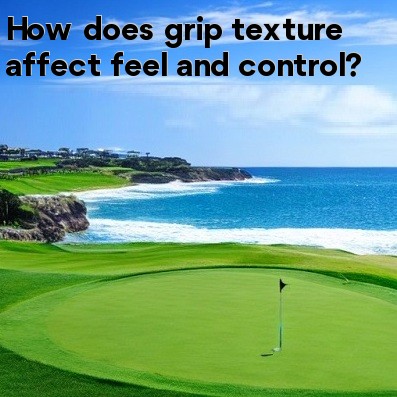
In golf, How does grip texture affect feel and control?
Grip texture plays a crucial role in a golfer's feel and control of the club. The grip is the golfer's only connection to the club, and a well-textured grip enhances the golfer's ability to maintain a secure hold, make consistent swings, and reduce the risk of the club slipping out of their hands during the swing.
- Enhanced Feel: The texture of a golf grip is designed to create friction between the golfer's hands and the grip surface. A textured grip provides more feedback and increases the golfer's sensitivity to the club's movement and position. This enhanced feel allows the golfer to make adjustments mid-swing and better control the clubface.
- Improved Control: A textured grip promotes better control over the club. The additional grip provided by the texture reduces the likelihood of the club sliding or twisting in the golfer's hands during the swing. This leads to more consistent ball striking and improved accuracy.
- Prevention of Slippage: Golfers often face challenges when playing in wet or humid conditions. Moisture can make the grip slippery, making it difficult to maintain grip pressure through the swing. However, a textured grip helps combat this issue by providing additional traction. The textures create friction with the golfer's hands, increasing the grip's resistance to sliding or twisting, even in adverse weather conditions.
- Personalized Preference: The texture of the grip is an individual preference. Some golfers prefer a rougher, more pronounced texture, while others prefer a finer texture. Different grip types offer various textures, allowing golfers to choose what feels most comfortable and provides the desired level of control. Finding the right combination of grip texture and performance can lead to improved overall performance on the course.
Some common grip textures found in golf include:
- Corded Grip: Corded grips feature a woven cord material beneath the grip's surface, providing enhanced traction and durability. These grips are particularly effective in wet or humid conditions.
- Rubber Grip: Rubber grips often feature a pattern of diamond or cross-hatched texture. This provides a solid grip and is preferred by many golfers for its durability and consistency.
- Velvet Grip: Velvet grips offer a soft and smooth texture. These grips provide a comfortable feel and can be suitable for golfers who do not require aggressive texture.
- Paddle Grip: Paddle grips have wider and flatter surfaces, offering more contact area with the golfer's hands. These grips can provide a confident feel and improved control.
It is important for golfers to regularly inspect their grips for wear and tear. Over time, grips can lose their texture, becoming smoother and potentially affecting the golfer's feel and control. If the grip texture deteriorates, it is recommended to replace the grip to maintain optimal performance.
In conclusion, grip texture in golf greatly influences a golfer's feel and control over the club. A well-textured grip enhances the golfer's ability to maintain a secure hold, make consistent swings, and prevent slippage. Choosing the right grip texture is a personal preference, and golfers should consider different options to find the texture that provides the desired level of control and comfort. Regular maintenance and replacement of worn grips are essential to maintain optimal performance on the course.





